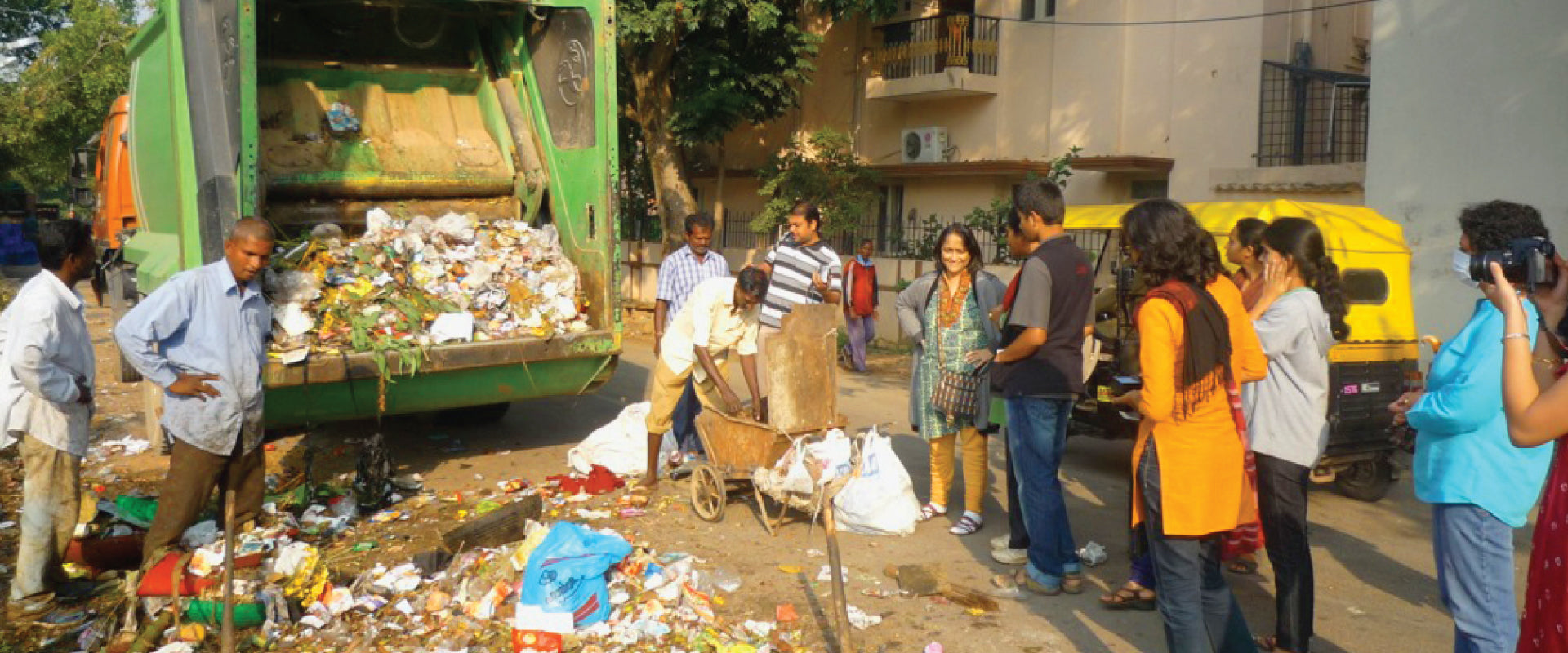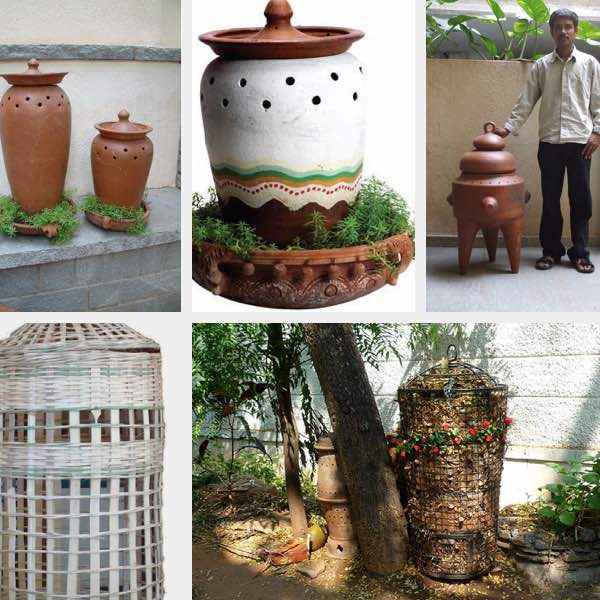Design Brief for ReRoute City

Design Brief
-
How can a city save its biomass (leaves, cuttings, branches, fronds) from being burnt or dumped in landfills?
-
How can it convert it into rich nutrition and go back to soil to increase soil fertility, water absorption, reduce erosion, mulch and increase soil organic matter?
-
Once solutions are put in place, how can they be maintained easily for the city to continue and endure the practice of saving leaves?
Project Premise
Impact of Saving Leaves

Click here to read how toxic the current practice of burning or hauling leaves to landfill can be.

Desired Project Outcomes
-
The city Is proud of creating circular pipelines for its biomass
-
Citizens learn and enjoy this aspect of their city’s resources
-
Nutrition goes back to soil and regenerates soil and mitigates climate change by sequestering carbon
Daily Dump's work with Leaf Composting
Daily Dump introduced the formal leaf composter in this form in 2006 when there were no takers.The first prototype was a terracotta leaf composter called Patta Kambha and this photo is from 29.10.2005 before we even launched the company formally! The 3 Legged leaf composter was created in April 2008 and the All Bamboo Leaf Composter came in March 2009 followed by the Bamboo & Metal versions and the Metal Mesh Composter in different sizes by the end of 2009.
To know more about the history of Daily Dump leaf composters, read this post.
See our current leaf composter designs
Now, over time there is greater awareness to save this important resource. People have bought this design in different parts of the city and replicated and adapted it too. In Bangalore alone we have people adapting this to implement in public and private spaces. Bangalore also has a different prototype of leaf saving in one ward in Koramangala. In Pune there is project called Brown Leaf that is inspired by our work. We feel now is the right time to explore to find new ways for the future city to treat dried biomass.
What you need to know to design a leaf composter
-
Who is incharge of dried leaves currently in the city? - Actually no one. We don't have a leaf policy - but we do have a rule that says you cannot burn leaves since it affects air quality. But saving leaves, ensuring leaf litter is valued for its really rich compost it produces, no. No document or charter protects leaves. Its assumed that they are a subset of Trees, so focus is on Trees!
-
Leaves in a city are the default responsibility of the garbage contractors and the leaves in the public parks are the responsibility of the Horticultural Department. In the height of the season large loads of leaves are sent to burn, bury in landfill or dumped in a ditch. In parks the leafs are put in a pile in a corner and large branches and fronds piled on the side of that space. Some parks have pits constructed for this and these are in one location together.
-
The perception of dried biomass in urban citizens and decision makers is “what a bother”. Many homes concrete their outside just to avoid muddy feet in rain, leaf litter becoming soggy - sweeping mud. The sanitised environment is preferred -'Pave everything, cut out view of soil'.
-
Farmers stock biomass carefully – they know the value and it is their natural capital and raw material
-
How does a leaf composter work? To learn how a leaf composter works, watch our films on leaf composting. You can also read more about Composting Leaves here.
-
What is the ideal size? The ideal size is dependent on whether you are designing a decentralised product or a semi-centralised one. The single volume one should not exceed 54 inches ht x 3.8 feet dia for effective composting. Larger diameters or widths take time for material inside to decompose.
-
What should it cost? It has to be reasonable for the context. An infrastructure approach can be a little more expensive, but for decentralised solutions each product needs to be within 9000 retail cost.
-
Which are the products that we have sold successfully? We have sold the cylindrical leaf composters most consistently and for some reason these have been adopted widely. The larger ones adapted by some of our clients tend to be cubiod, large house like structures, very much like the spaces used to store coconut in the west coast region.
What are the good to know details?
-
Dried leaves need to be watered daily for composting to happen. The volume then gets heavy and if the product is not placed on some elevated and strong base, it will sink into the mud and the water will collect below and cause a stink and mosquitoes will breed. If a leaf composter is not watered daily and only twice a week, then composting slows down and if leaves are too dry, it can turn into a fire hazard if someone drops a match.
-
Also we have found that if there is no cover in public places, the leaf composter ends up being a dustbin.
-
Most people do not recognise the value of dried leaves.
-
Shredders hold a promise, so people buy them, then if it is not a company that enforces use or has a really efficient shredder, gardeners end up not-shredding. Shredding takes more work, more time and it is noisy.
-
Adding cowdung slurry, microbes and other bacterial cultures speeds up composting.
-
Harvesting compost is tedious, so designing for ergonomics and ease of effort helps use of the product. Leaves seem to be dry outside, but inside they are composting and all very tightly packed, removing this tight material takes effort if harvesting is done before the 12 months.
-
Earthworms come in naturally in most places. If there are termites in an area, they too arrive in large numbers.
-
Holding composted leaves is also part of the problem. Rats tear away on sacks putting thin pieces of plastic in the done compost, not desirable and jute sacks just decompose if the compost does not get hauled to site of use.
-
Pelletisation of done compost is possible. Pelletisation of dried leaves is also possible. It reduces volume by one third.
-
Wherever there is political will to install these, they work till such time there is some interest. Because this is not monetised it is not sustainable over time.
Typical customers of Centralised and Decentralised approaches
While the kinds of communities that adopt these approaches might vary, the attitude of considering dried leaves an 'eyesore' and therefore keeping it 'out of sight and off bounds' is common. If both groups could only find a way to make leaf composting visible and more like a learning space, then awareness of this idea would spread.
Centralised
-
Parks managed by Municipalities. They are stuck to the idea of one area in the park will be assigned for leaves - the idea of leaf composters being distributed is still not in their horizon.
-
A RWA either of a ward area or within a gated community - they think that managing with the public pick up system or internal housekeeping staff and taking care of it at a central space allows better control and more efficiencies and avoids problems of leaf litter being mixed with other waste.
If both these users could only find a way to make this visible and like a learning space then awareness of this idea would spread. Often these areas are an eyesore and "off bounds". So out of sight out of mind as an attitude is cemented further.
Decentralised
-
In individual homes -
-
In schools
-
In smaller corporate spaces where there is interest in leaf composting
-
In public spaces like streets where there is political will
-
In public parks, lakes, tourist spaces where there is political will.
Must Have in the Designed Solution
-
Vandal Proof
-
Usable in public and private spaces
-
Made to last
-
Easy to fill and easy to harvest
-
Not become a dustbin
-
If it is a product – then should not exceed Rs 9000 per unit in cost.
-
If it is a bigger solution, then it should not exceed Rs 25,000 in cost.
-
Design suggestion of a maintenance plan (Corporate CSR)
-
All weather proof
-
Easy-to-ship
-
Space to put sponsor name
-
Can be adapted locally
Good to have in the Designed Solution
-
Should bring in other elements like insect, bird and creature life
-
Enable learning of stuff that we should know but don’t! You can choose!
-
Help create new relationships with trees, dried leaves and nature.
-
Grow knowledge of the circular flow – show where the compost goes
-
Show how a city is not doing its job if it does not look after its resources
Daily Dump's experiments with Leaf Composter Designs

These metal leaf composters designed in collaboration with a design house had a niche audience. The capacity was also less than expected as leaves take a long time to decompose.

This was an experiment to create a space just to hold the bags of leaves stored by gardeners. The idea was to dot it at different intervals in a corporate space or garden.

This was designed using a plastic covered mesh of smaller size and making a product that could be dismantled. However the fabricator said it was more work and we did not pursue it further as the costs would be high.
 We experimented to see how walls can also be leaf composters? And urinals too.
We experimented to see how walls can also be leaf composters? And urinals too.

This street project was initiated in April 2011 and Mr. Srinivasa Raju funded this project for his neighbourhood in Bengaluru. Read this to know about how this community continues to create a leaf safe zone in their neighbourhood!
Daily Dump's work with Street Leaf Composting







DIY Solutions

DIY solutions can be small or large. The picture just above shows a pile version popular with farmers for large volumes of dried leaves. Wetting dried leaves in cowdung and jaggery slurry speeds up composting substantially.
Large composters built by Daily Dump customers and by the PPP model






Daily Dump Aug 2018







